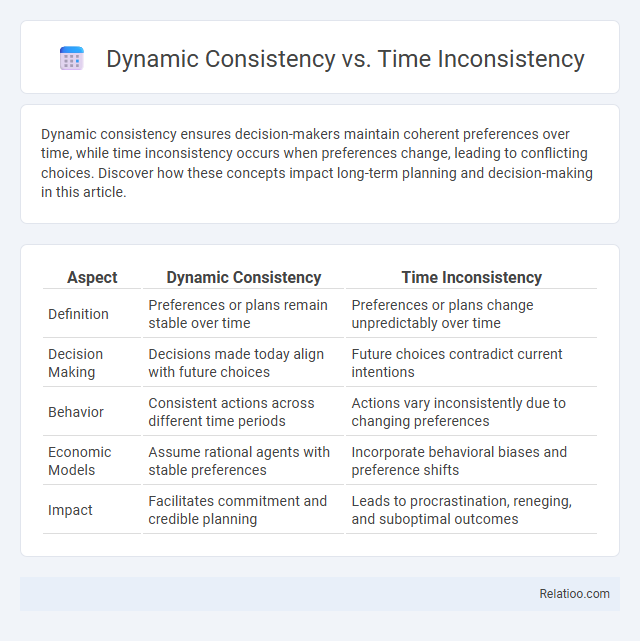Dynamic consistency ensures decision-makers maintain coherent preferences over time, while time inconsistency occurs when preferences change, leading to conflicting choices. Discover how these concepts impact long-term planning and decision-making in this article.
Table of Comparison
| Aspect | Dynamic Consistency | Time Inconsistency |
|---|---|---|
| Definition | Preferences or plans remain stable over time | Preferences or plans change unpredictably over time |
| Decision Making | Decisions made today align with future choices | Future choices contradict current intentions |
| Behavior | Consistent actions across different time periods | Actions vary inconsistently due to changing preferences |
| Economic Models | Assume rational agents with stable preferences | Incorporate behavioral biases and preference shifts |
| Impact | Facilitates commitment and credible planning | Leads to procrastination, reneging, and suboptimal outcomes |
Understanding Dynamic Consistency
Dynamic consistency ensures that your initial plan remains optimal as time progresses and new information unfolds, preventing preference reversals. Time inconsistency occurs when your preferences change over time, leading to decisions that contradict earlier plans and potentially undermining long-term goals. Understanding dynamic consistency helps you develop strategies that maintain commitment and coherence throughout changing circumstances.
Defining Time Inconsistency
Time inconsistency refers to a situation where an individual's preferences change over time, leading to decisions that contradict earlier plans or commitments. Dynamic consistency occurs when preferences remain stable across different time periods, ensuring that planned actions align with future choices. Understanding time inconsistency is crucial in economics and behavioral science, as it explains why people may deviate from their optimal long-term strategies.
Origins of Time-Inconsistent Behavior
Time-inconsistent behavior originates from the conflict between immediate rewards and future benefits, often driven by hyperbolic discounting, where individuals disproportionately prioritize present consumption over long-term gains. Dynamic consistency ensures that preferences remain stable over time, aligning decisions across different periods, while time inconsistency reflects changing preferences that lead to choices one may later regret. Your understanding of these concepts is crucial for designing policies or strategies that mitigate impulsive decision-making and promote long-term planning.
Psychological Foundations of Dynamic Consistency
Dynamic consistency refers to the alignment of your preferences over time, ensuring decisions made today remain optimal in the future despite changing circumstances. Time inconsistency occurs when your preferences shift, causing choices that once seemed best to later appear suboptimal, often due to psychological factors like temptation or changing valuation of outcomes. The psychological foundations of dynamic consistency emphasize cognitive processes such as self-control, foresight, and commitment mechanisms that help maintain stable preferences and rational decision-making over time.
Economic Implications of Time Inconsistency
Time inconsistency in economics occurs when a decision-maker's preferences change over time, leading to plans made today being abandoned in the future, which can undermine credible commitment and policy effectiveness. Dynamic consistency ensures decisions remain optimal and aligned across different periods, crucial for ensuring predictable economic policies and stable expectations among agents. Your understanding of time inconsistency highlights challenges like inflationary bias and suboptimal savings, impacting long-term growth and welfare outcomes.
Real-World Examples of Time-Inconsistent Decisions
Dynamic consistency ensures that your preferences remain stable over time, allowing plans made today to be followed through in the future without change. Time inconsistency occurs when decisions that seem optimal initially are later reversed due to shifting preferences, as seen in procrastination of saving for retirement or unhealthy eating habits despite intentions to improve health. Real-world examples like smokers regretting past indulgences or patients abandoning exercise routines highlight how dynamic choices clash with time-inconsistent behaviors, emphasizing the challenge of maintaining long-term commitment.
Strategies to Promote Dynamic Consistency
Strategies to promote dynamic consistency focus on aligning preferences and decisions over time to avoid conflicts between present and future selves. Commitment devices, such as binding contracts or automatic savings plans, help individuals stick to long-term goals despite short-term temptations. Transparent feedback mechanisms and regular self-monitoring also enhance dynamic consistency by reinforcing awareness of long-term objectives and the consequences of time-inconsistent behavior.
Dynamic Consistency in Behavioral Economics
Dynamic consistency in behavioral economics refers to the alignment between a person's planned preferences and their actual choices over time, ensuring that decisions made today remain consistent in the future. Time inconsistency occurs when preferences change, causing a divergence between initial plans and subsequent actions, often leading to procrastination or impulsive behavior. Understanding dynamic consistency helps You design commitment devices and policies that promote long-term goal adherence by addressing behavioral time inconsistencies.
Policy Approaches to Address Time Inconsistency
Policy approaches to address time inconsistency focus on designing credible commitment mechanisms that ensure future actions align with current plans, reducing the risk of dynamic inconsistency in decision-making. Dynamic consistency requires policies that maintain stable preferences over time, such as binding contracts or automatic adjustment rules, to prevent deviations driven by changing incentives. Your ability to implement rules that enforce forward-looking consistency safeguards policy effectiveness and promotes long-term economic stability.
Future Directions in Consistency Research
Dynamic consistency ensures that your preferences remain stable over time, enabling coherent decision-making across different stages. Time inconsistency highlights the tendency for preferences to change, often leading to choices that contradict earlier plans due to shifting valuations or impatience. Future directions in consistency research focus on integrating behavioral models with advanced computational techniques to predict and manage decision-making under uncertainty more effectively.

Infographic: Dynamic Consistency vs Time Inconsistency
 relatioo.com
relatioo.com